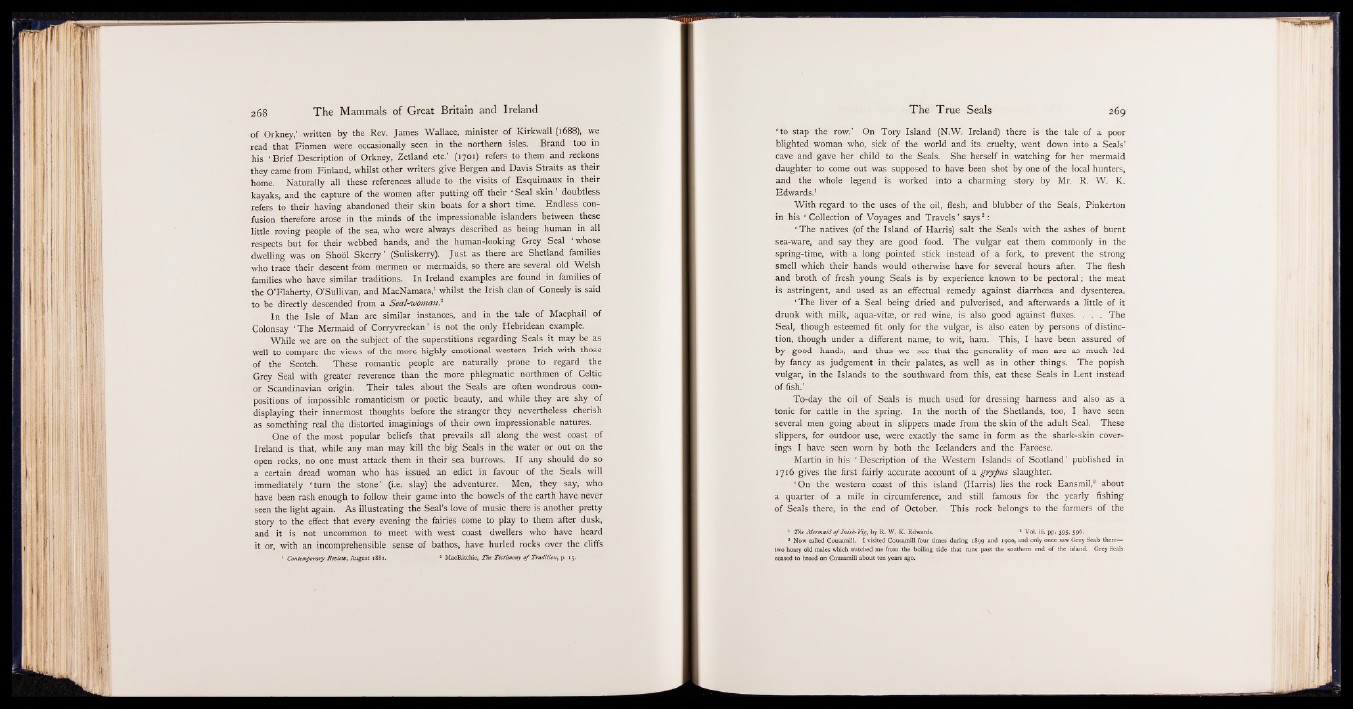
of Orkney,’ written by the Rev. James Wallace, minister of Kirkwall (1688), we
read that Finmen were occasionally seen in the northern isles. Brand too in
hi3 Brief Description of Orkney, Zetland etc.’ (1701) refers to them and reckons
they came from Finland, whilst other writers give Bergen and Davis Straits as their
home. Naturally all these references allude to the visits of Esquimaux in their
kayaks, and the capture of the women after putting off their ’ Seal skin ’ doubtless
refers to their having abandoned their skin boats for a short time. Endless confusion
therefore arose in the minds of the impressionable islanders between these
little roving people of the sea, who were always described as being human in all
respects but for their webbed hands, and the human-looking Grey Seal ‘ whose
dwelling was on Shool Skerry’ (Suliskerry). Just as there are Shetland families
who trace their descent from mermen or mermaids, so there are several old Welsh
families who have similar traditions. In Ireland examples are found in families of
the O’Flaherty, O'Sullivan, and MacNamara,1 whilst the Irish clan of Coneely is said
to be directly descended from a Seal-woman.2
In the Isle of Man are similar instances, and in the tale of Macphail of
Colonsay ‘ The Mermaid of Corryvreckan ’ is not the only Hebridean example.
While we are on the subject of the superstitions regarding Seals it may be as
well to compare the views of the more highly emotional western Irish with those
of the Scotch. These romantic people are naturally prone to regard the
Grey Seal with greater reverence than the more phlegmatic northmen of Celtic
or Scandinavian origin. Their tales about the Seals are often wondrous compositions
of impossible romanticism or poetic beauty, and while they are shy of
displaying their innermost thoughts before the stranger they nevertheless cherish
as something real the distorted imaginings of their own impressionable natures.
One of the most popular beliefs that prevails all along the west coast of
Ireland is that, while any man may kill the big Seals in the water or out on the
open rocks, no one must attack them in their sea burrows. If any should do so
a certain dread woman who has issued an edict in favour of the Seals will
immediately ‘ turn the stone’ (i.e. slay) the adventurer. Men, they say, who
have been rash enough to follow their game into the bowels of the earth have never
seen the light again. As illustrating the Seal’s love of music there is another pretty
story to the effect that every evening the fairies come to play to them after dusk,
and it is not uncommon to meet with west coast dwellers who have heard
it or, with an incomprehensible sense of bathos, have hurled rocks over the cliffs
1 Contemporary Review, August 1881. * MacRitchie, The Testimony o f Tradition, p. 15.
‘ to stap the row.’ On Tory Island (N.W. Ireland) there is the tale of a poor
blighted woman who, sick of the world and its cruelty, went down into a Seals’
cave and gave her child to the Seals. She herself in watching for her mermaid
daughter to come out was supposed to have been shot by one of the local hunters,
and the whole legend is worked into a charming story by Mr. R. W. K.
Edwards.1
With regard to the uses of the oil, flesh, and blubber of the Seals, Pinkerton
in his ‘ Collection of Voyages and Travels ’ says2:
‘ The natives (of the Island of Harris) salt the Seals with the ashes of burnt
sea-ware, and say they are good food. The vulgar eat them commonly in the
spring-time, with a long pointed stick instead of a fork, to prevent the strong
smell which their hands would otherwise have for several hours after. The flesh
and broth of fresh young Seals is by experience known to be pectoral; the meat
is astringent, and used as an effectual remedy against diarrhoea and dysenterea.
‘ The liver of a Seal being dried and pulverised, and afterwards a little of it
drunk with milk, aqua-vitae, or red wine, is also good against fluxes. . . . The
Seal, though esteemed fit only for the vulgar, is also eaten by persons of distinction,
though under a different name, to wit, ham. This, I have been assured of
by good hands, and thus we see that the generality of men are as much led
by fancy as judgement in their palates, as well as in other things. The popish
vulgar, in the Islands to the southward from this, eat these Seals in Lent instead
of fish.’
To-day the oil of Seals is much used for dressing harness and also as a
tonic for cattle in the spring. In the north of the Shetlands, too, I have seen
several men going about in slippers made from the skin of the adult Seal. These
slippers, for outdoor use, were exactly the same in form as the shark-skin coverings
I have seen worn by both the Icelanders and the Faroese.
Martin in his ‘ Description of the Western Islands of Scotland’ published in
1716 gives the first fairly accurate account of a gryfius slaughter.
‘ On the western coast of this island (Harris) lies the rock Eansmil,8 about
a quarter of a mile in circumference, and still famous for the yearly fishing
of Seals there, in the end of October. This rock belongs to the farmers of the
1 The Mermaid ofln ish - Vig, by R. W. K. Edwards. * VoL iii. pp. 395, 596.
3 Now called Cousamill. I visited Cousamill four times during 1899 and 1900, and only once saw Grey Seals there—
two hoary old males which watched me from the boiling tide that runs past the southern end of the island. Grey Seals
ceased to breed on Cousamill about ten years ago.